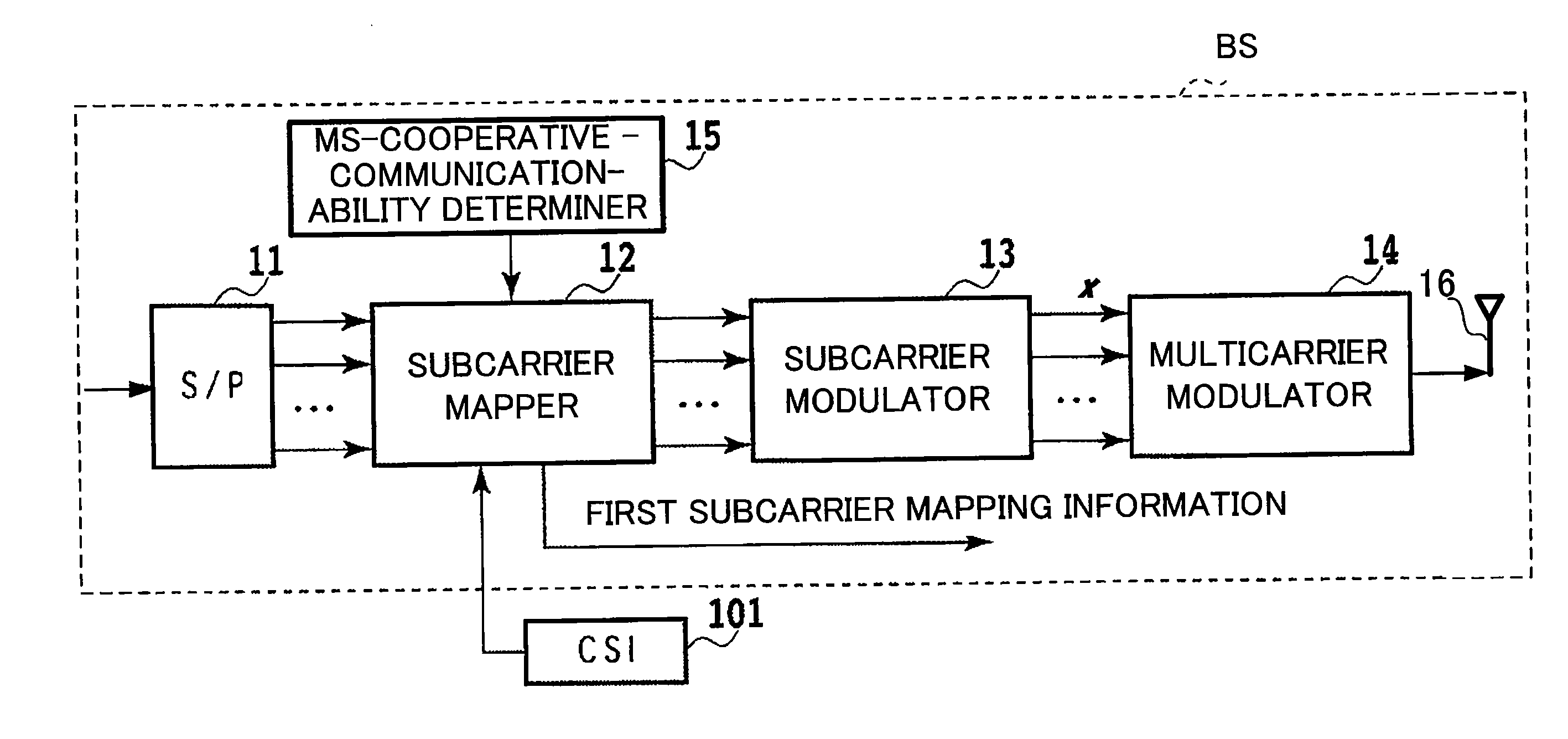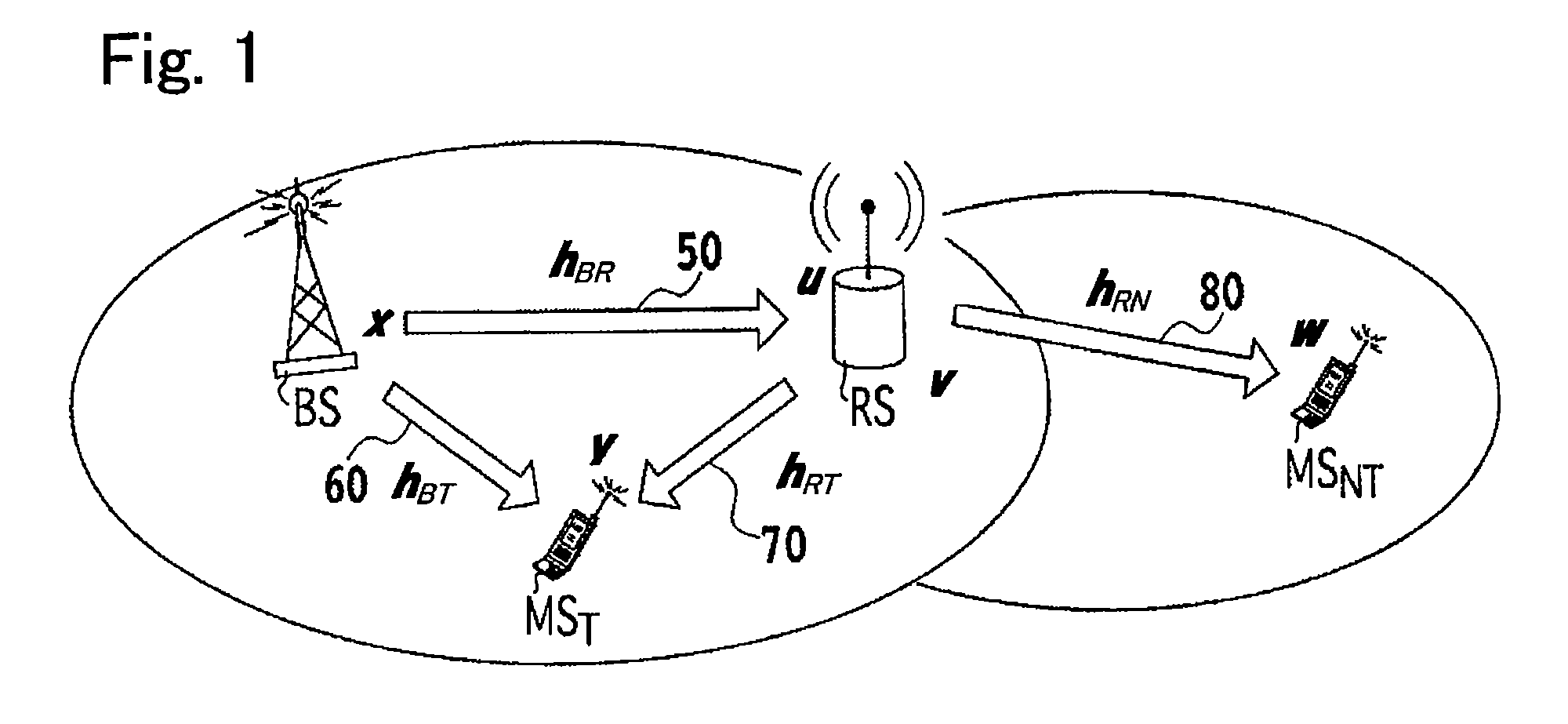Multicarrier radio communication system, base station, radio relay station, mobile station, and multicarrier radio communication method
a radio communication system and multi-carrier technology, applied in the direction of digital transmission, transmission path division, transmission path sub-channel allocation, etc., can solve the problems of affecting the transmission of signals, so as to prevent interference
- Summary
- Abstract
- Description
- Claims
- Application Information
AI Technical Summary
Benefits of technology
Problems solved by technology
Method used
Image
Examples
first embodiment
Radio Communication System
[0077]FIG. 1 is a view showing the overall structure of a multicarrier radio communication system (radio relay system), especially showing parts of the radio relay system which pertains to the present invention. In the embodiment, the present invention is applied to downlink communications.
[0078]As shown in FIG. 1, the radio relay system includes a base station (radio communication apparatus) BS, a radio relay station (radio relay apparatus) RS having a radio relay function. The radio relay system further includes a first mobile station MST (radio communication apparatus) located at a position where it is possible to directly communicate with the base station and to communicate with the radio relay station, so that the first mobile station MST can perform cooperative communication. The radio relay system further includes a second mobile station (radio communication apparatus) MSNT located at a position where it is impossible to directly communicate with the...
example of first embodiment
[0114]Next, with reference to FIGS. 6A through 9B, an example of a radio communication method in which radio resources are allocated in accordance with this embodiment will be described. This method is carried out in a radio relay system using OFDMA as the multicarrier communication scheme. In the example, each of the base station BS, the radio relay station RS, and the mobile stations has a single antenna in order to execute half-duplex relay in which reception and transmission at the relay station RS are conducted at different time slots.
[0115]In the following description, each parameter denoted in bold face is a vector form consisting of values at different frequencies (subcarriers), whereas each parameter denoted in small face is a scalar form having a value at a frequency (subcarrier).
[0116]FIG. 6A is a diagram showing a communication status at time slot [2i−1] where i is a natural number. As shown in FIG. 6A, the base station BS as the transmission source transmits to the radi...
second embodiment
[0151]A second embodiment of the present invention will be described below. In the following description, differences between the first and second embodiments will be elaborated.
[0152]In the first embodiment, at time slot [2i] where i is a natural number, only the radio relay station RS sends downlink parallel signals v[2i]. In the second embodiment, at time slot [2i], the base station BS sends downlink parallel signals y[2i] of which the contents are the same as in the parallel signals y[2i−1] previously transmitted, and simultaneously, the radio relay station RS sends downlink parallel signals v[2i] of which the contents are the same as in the parallel signals y[2i−1] previously transmitted from the base station BS. This may further improve the cooperative diversity gain at the mobile station MST. For this purpose, the subcarrier mapper 12 resends to the subcarrier modulator 13 the parallel signals previously transmitted destined for the first mobile station MST. The subcarrier ma...
PUM
 Login to View More
Login to View More Abstract
Description
Claims
Application Information
 Login to View More
Login to View More - R&D
- Intellectual Property
- Life Sciences
- Materials
- Tech Scout
- Unparalleled Data Quality
- Higher Quality Content
- 60% Fewer Hallucinations
Browse by: Latest US Patents, China's latest patents, Technical Efficacy Thesaurus, Application Domain, Technology Topic, Popular Technical Reports.
© 2025 PatSnap. All rights reserved.Legal|Privacy policy|Modern Slavery Act Transparency Statement|Sitemap|About US| Contact US: help@patsnap.com



